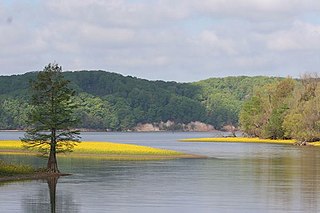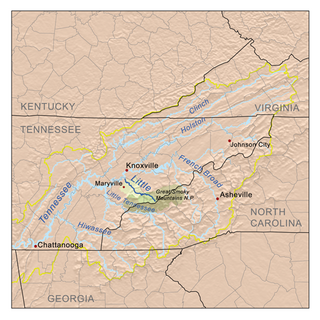
The Mississippi River is the second-longest river and chief river of the second-largest drainage system on the North American continent, second only to the Hudson Bay drainage system. From its traditional source of Lake Itasca in northern Minnesota, it flows generally south for 2,320 miles (3,730 km) to the Mississippi River Delta in the Gulf of Mexico. With its many tributaries, the Mississippi's watershed drains all or parts of 32 U.S. states and two Canadian provinces between the Rocky and Appalachian mountains. The main stem is entirely within the United States; the total drainage basin is 1,151,000 sq mi (2,980,000 km2), of which only about one percent is in Canada. The Mississippi ranks as the fifteenth-largest river by discharge in the world. The river either borders or passes through the states of Minnesota, Wisconsin, Iowa, Illinois, Missouri, Kentucky, Tennessee, Arkansas, Mississippi, and Louisiana.

Tennessee, officially the State of Tennessee, is a state in the Southeastern region of the United States. Tennessee is the 36th largest by area and the 16th most populous of the 50 states. It is bordered by eight states, with Kentucky to the north, Virginia to the northeast, North Carolina to the east, Georgia, Alabama, and Mississippi to the south, Arkansas to the west, and Missouri to the northwest. The Appalachian Mountains dominate the eastern part of the state, and the Mississippi River forms its western border. Nashville is the state's capital and largest city, with a 2019 population of 670,820 and a 2019 metro population of 1,934,317. Tennessee's second largest city is Memphis, which had a population of 651,073 and metro population of 1,346,045 in 2019.

Ducktown is a city in Polk County, Tennessee, United States. The population was 427 at the 2000 census and 475 at the 2010 census. It is included in the Cleveland Metropolitan Statistical Area.

The Charles River is an 80-mile (129 km) long river in eastern Massachusetts. From its source in Hopkinton the river's mouth is northeast of its headwaters, though it follows a highly meandering route, doubling back on itself several times and traveling through 23 cities and towns before reaching the Atlantic Ocean at Boston. The Native-American name for the Charles River is Quinobequin, meaning "meandering".
The Piney River is a 23.7-mile-long (38.1 km) tributary of the Duck River in Middle Tennessee in the United States. Via the Duck River, the Tennessee River, and the Ohio River, it is part of the Mississippi River watershed. The headwater tributaries of the Piney River rise in Dickson County, Tennessee, near the city of Dickson. Dickson is located on the "Tennessee Valley Divide", which corresponds for some distance with the downtown's Main Street. The western part of the town, the part in the Tennessee Valley, is drained by the East Piney River, a tributary to the Piney.

The Buffalo River is the longest unimpounded river in Middle Tennessee in the United States, flowing 125 miles (201 km) through the southern and western portions of that region. It is the largest tributary of the Duck River and is used for canoeing, especially in its middle section. The river is named for the Buffalo fish which was abundant when the first European settlers arrived.

The Duck River, 284 miles (457 km) long, is the longest river located entirely within the U.S. state of Tennessee. Free flowing for most of its length, the Duck River is home to over 50 species of freshwater mussels and 151 species of fish, making it the most biologically diverse river in North America.

The Mokelumne River is a 95-mile (153 km)-long river in northern California in the United States. The river flows west from a rugged portion of the central Sierra Nevada into the Central Valley and ultimately the Sacramento–San Joaquin River Delta, where it empties into the San Joaquin River-Stockton Deepwater Shipping Channel. Together with its main tributary, the Cosumnes River, the Mokelumne drains 2,143 square miles (5,550 km2) in parts of five California counties. Measured to its farthest source at the head of the North Fork, the river stretches for 157 miles (253 km).

The Stanislaus River is a tributary of the San Joaquin River in north-central California in the United States. The main stem of the river is 96 miles (154 km) long, and measured to its furthest headwaters it is about 150 miles (240 km) long. Originating as three forks in the high Sierra Nevada, the river flows generally southwest through the agricultural San Joaquin Valley to join the San Joaquin south of Manteca, draining parts of five California counties. The Stanislaus is known for its swift rapids and scenic canyons in the upper reaches, and is heavily used for irrigation, hydroelectricity and domestic water supply.

The Conasauga River is a river that runs through southeast Tennessee and northwest Georgia. The Conasauga River is 93 miles (150 km) long and is home to 90 species of fish and 25 species of freshwater mussels. The Conasauga River watershed encompasses over 500,000 acres (2,000 km2) in two states, multiple counties, and two ecologically different regions.

Tennessee National Wildlife Refuge is a National Wildlife Refuge of the United States located along the shores of the Tennessee River in West Tennessee. It was established in 1945 where the impoundment of Kentucky Lake by the Tennessee Valley Authority has created a more-or-less permanent wetlands environment favored by many species of waterfowl. The entire refuge area is 51,359.46 acres (207.84 km²) in three units: From north to south they are Big Sandy, Duck River, and Busseltown.

The Conasauga logperch is a species of freshwater ray-finned fish, a darter from the subfamily Etheostomatinae, part of the family Percidae, which also contains the perches, ruffes and pikeperches. It is endemic to the United States. It is one of 184 species of darters in North America. It has been listed as endangered throughout its range with critical habitat since August 5, 1985.

The Old Stone Fort is a prehistoric Native American structure located in Coffee County, Tennessee, in the Southeastern United States. The structure was most likely built between 80 and 550 AD during the Middle Woodland period. It is the most complex hilltop enclosure found in the South and was likely used for ceremonial purposes rather than defense.

The American River is a 30-mile-long (50-kilometer) river in California that runs from the Sierra Nevada mountain range to its confluence with the Sacramento River in downtown Sacramento. Via the Sacramento River, it is part of the San Francisco Bay watershed. This river is fed by the melting snowpack of the Sierra Nevada and its many headwaters and tributaries, including the North Fork American River, the Middle Fork American River, and the South Fork American River.
The Dragon Run watershed in the U.S. state of Virginia encompasses 140 square miles (360 km2) and is home to many flora and fauna species. The brackish water stream, labeled on topographic maps as Dragon Swamp, is fed by underground springs, surface runoff, and numerous feeding swamps. In a study of 232 rivers and streams in the Chesapeake Bay, the Nature Conservancy and the Chesapeake Bay Foundation found the Dragon Run to rank second in terms of ecological significance. Efforts are being made to preserve the Dragon Run, including Governor Tim Kaine’s large purchase of land in order to maintain and protect the watershed’s original state.

The Little Tennessee Watershed Association (LTWA) is a conservation organization formed in 1993 in Franklin, NC to protect and restore the health and waters of the Little Tennessee River and its tributaries upstream of the Fontana reservoir through monitoring, education, habitat restoration, and citizen action. With around 140 members, the organization advocates for the conservation of the watershed in Macon County and its surrounding counties, helps protect and restore at-risk properties in the watershed, and maintains a biomonitoring program that charts the quality of aquatic life and biodiversity of the river.

Duck Creek is a minor tributary of the Mississippi River in the United States. The creek runs through Scott County, Iowa, and the cities of Davenport, Bettendorf, and Riverdale.

The flame chub is a species of freshwater fish in the family Cyprinidae found only in the United States. Its range broadly follows the Tennessee River from above Knoxville, Tennessee, to the mouth of the Duck River. Historically the species was found in Kentucky, Tennessee, Alabama and Georgia. The preferred habitat of flame chub is in small flowing streams often associated with springs.
Etheostoma obama, the spangled darter, is a species of freshwater ray-finned fish, a darter from the subfamily Etheostomatinae, part of the family Percidae, which also contains the perches, ruffes and pikeperches. It is endemic to the eastern United States where it is only known to occur in the Duck River and the Buffalo River, both in Tennessee.

The Duck River Cache was the archaeological discovery of 46 Mississippian culture artifacts by a worker on at the Link Farm Site in Middle Tennessee in December 1894.















